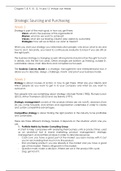Chapter 7, 8, 9, 10, 13, 14 and 15 → Arjan van Weele
Strategic Sourcing and Purchasing
Week 1
Strategy is part of the main goal, in how you get there.
Vision: what is the purpose of this organisation?
Mission: what do we want to achieve?
Values: what are our leading values? (also asked by customers)
Strategies: how will we achieve our vision & mission?
When you start your strategy you need execution people, who know what to do and
how to do it. Secondly, you need to continuously evaluate to know if you are still on
the right path.
The business strategy is changing as well. All long terms should not be thought to much
in details, only the first two years. Other changes are bottom up thinking, outside in,
sustainable values, main directions and competence focused.
The Business Canvas Model is a strategic management and entrepreneurial tool. It
allows you to describe, design, challenge, invent, and pivot your business model.
Week 2
Strategy is about courses of action; in how to get there. What are your talents and
which people do you want to get in to your company and what do you want to
outsource.
Few people who say something about strategy: Michael Porter (1985), Richard Lynch
(2012), Arthur Thompson (2012) and Jay Barney (1991).
Strategic management consists of the analysis (where are we now?), decisions (how
do you come forward), and actions and organization undertakes in order to create
and sustain competitive advantages.
Competitive strategy is about finding the right position in the industry to be profitable
and sustainable.
There are three different strategy models. It depends on the situation which one you
use.
1. Portfolio Matrix by Boston Consulting Group
A chart to help companies with analysing their business units or product lines, used
as an analytical tool in brand marketing, product management, strategic
management, and portfolio analysis in order to allocate resources.
- Cash cow: you have a good part of the market; you earn money with it, but
you’re not investing that much in to this product.
- Star: promising product; you are already in the market and you have a good
size of the market. There is still growth in the market.
- Question mark: make a decision. Where are we in the product life cycle.
- Dog: get rid of it.
, Chapter 7, 8, 9, 10, 13, 14 and 15 → Arjan van Weele
2. Multifactor Portfolio Matrix by GE & McKinsey
Is about industry attractiveness and business strengths.
3. Five Forces Model by
Michael Porter
A framework for industry analysis
and business strategy
development using concepts to
derive five forces which
determine the competitive
intensity and therefore the
attractiveness of a market
expressed in the overall industry
profitability. This model focusses
more on a holistic approach
instead of two factors.
There are three well known basic strategy approaches.
1. The Three Generic Strategies by Michael Porter
A category scheme consisting of three general types of strategies that are
commonly used to achieve and maintain competitive advantage, defined along
the dimensions strategic scope (demand-side dimension) and strategic strength
(supply-side dimension).
- Cost: efficiency
- Differentiation: image, functionalities (different features, service)






